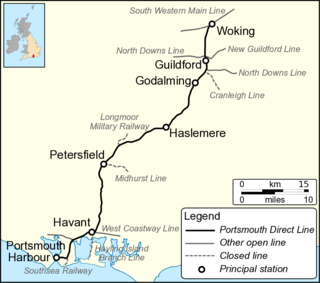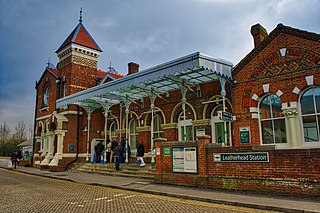History
Croydon and Epsom Railway

The London and Croydon Railway was operational in 1839, and by means of an affiliated company, the Croydon and Epsom Railway, had powers granted on 29 July 1844 to reach Epsom. [1] The London and Croydon Railway amalgamated with the London and Brighton Railway and the Croydon and Epsom Railway, as well as certain others, resulting in the formation of the London, Brighton and South Coast Railway (LBSCR), by Act of 27 July 1846. [2]
The Croydon and Epsom line opened to Epsom on 10 May 1847. [3] The Epsom station was some way east of the present-day station, on the north side of Upper High Street. [4]
Epsom and Leatherhead Railway
On 14 July 1856 the Epsom and Leatherhead Railway was authorised, with authorised share capital of £30,000. An independent short line, it had suffered antagonistic opposition in Parliament, which prevented it from extending at either end. The E&LR had no large company sponsoring it, and its supporters were free to secure the support of the LBSCR or the LSWR. The E&LR was completed on 1 February 1859 and worked by the LSWR. For a short time it was isolated from other railways. [5] [6] [7] [8]
Wimbledon and Dorking Railway

Independent promoters put forward a Wimbledon and Dorking Railway, intended to extend the E&LR at each end. It would leave the LSWR main line west of Wimbledon, and run to Epsom, and then from Leatherhead to Dorking. The first prospectus showed a connection at Dorking to the South Eastern Railway, which ran west to east between Guildford and Reigate. However the W&DR Parliamentary Bill in the 1857 session applied only for the northern section, 5+3⁄4 miles long. The Act was passed on 27 July 1857; the authorised share capital was £70.000. The LSWR had opposed at first, but was mollified by an agreement that it should work and maintain the line for forty-five per cent of gross receipts, taking £30,000 in shares and appointing two directors. [8] [7] [5]
The LSWR had made a territorial exclusivity agreement several years previously: each agreed not to make or encourage lines that encroached into the other's natural territory, and when the E&LR asked the LSWR to work its line, the LSWR primly refused. The W&DR did not enter into the disputed territory, and was falling into the LSWR camp, but a proposed amalgamation of the W&DR and the ELR would infringe the agreement, and the LSWR opposed an 1858 Bill proposing that amalgamation. [8]
The W&DR double line, surveyed by Crosse, was built by Thomas Brassey, though bad weather and scarcity of men and materials made him late with both. The W&DR line was opened to traffic on 4 April 1859; the junction with the LSWR main line was named Epsom Junction, and was located at the site of the later Raynes Park station. Like the E&LR, the line was worked by the LSWR. [5] [7] [8]
In 1859 the W&DR owning company made an alliance with the Epsom and Leatherhead Railway and the proposed Portsmouth Direct Railway, intending to extend from Leatherhead to Dorking, and ultimately Portsmouth via Chichester, but this project was turned down by Parliament in 1859. [8] On 29 July 1859 the LBSCR reached an agreement settling further territorial disputes; part of the agreement left the LBSCR in sole possession of the area south of Leatherhead, and the aspirations of the W&DR to extend in that direction were at an end. [8]
Epsom stations
On 8 August 1859 the Epsom station of the LBSCR was connected to the E&LR and LBSCR trains worked through on to that line. The Wimbledon line had a passenger train service of seven trains every weekday. [9]
Absorption of the WDR
In 1860 the W&DR complained bitterly that its legitimate income was restricted because of diversion of traffic by the LBSCR. The LSWR decided it was time to buy out the W&DR and made an offer, but it was turned down by W&DR shareholders. The W&DR had a short section of line at Epsom, which the LBSCR used to reach the E&LR and the W&DR started proceedings in the High Court to prevent the LBSCR using it. Further petulant measures followed, but at length it was obvious that the future involved a takeover by the LSWR, and this was agreed from 3 April 1861. [10] [7]
The LSWR absorbed the W&DR by Act of 3 June 1862. [5] [7] [8]
Train service
The 1904 timetables show 22 down trains to Epsom. [11]
Raynes Park station and junction
A station opened at Epsom Junction, where the W&DR converged with the LSWR main line. It was called Raynes Park, and its opening date was 30 October 1871. AT first it served only the Epsom line and the Kingston line. This was followed on 16 March 1884 by the commissioning of a burrowing junction there, by which the Up Epsom line was carried under the main lines to avoid conflicts. [12]
Electrification
Surrey's first section of the Southern Electric came into operation on 12 July 1925, running over the lines from Raynes Park to Epsom and Dorking. The third rail direct current system was used. [13] [14]














